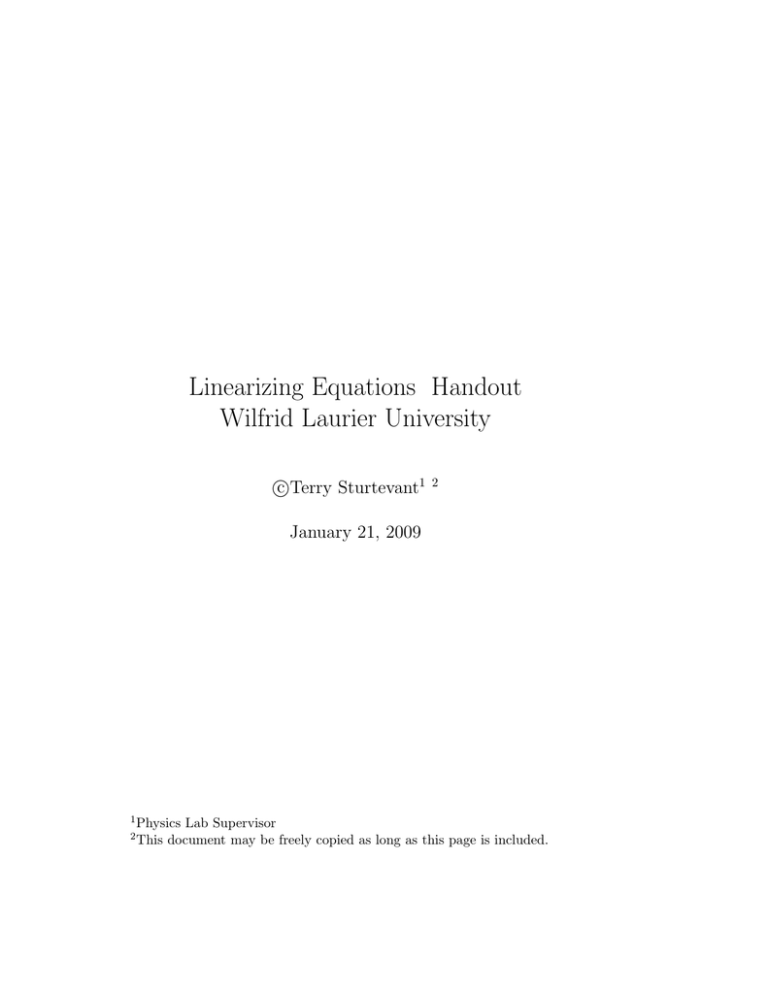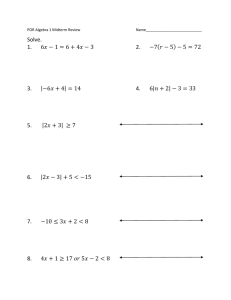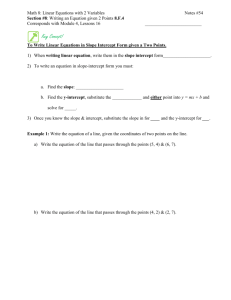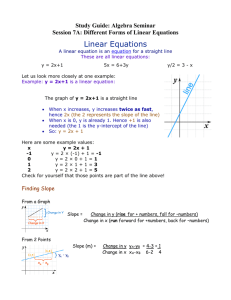Document 10713640
advertisement

Linearizing Equations Handout Wilfrid Laurier University c Terry Sturtevant1 2 January 21, 2009 1 Physics 2 This Lab Supervisor document may be freely copied as long as this page is included. ii January 21, 2009 Chapter 1 Linearizing Equations 1.1 Theory Often, the point of a scientific experiment is to try and find empirical values for one or more physical quantities, given measurements of some other quantities and some mathematical relationship between them. For instance, given a marble has a mass of 5 g, and a radius of 0.7 cm, the density of the marble can be calculated given that v = 4/3πr3 and ρ = m/v. (For the sake of simplicity, uncertainties will be ignored for now, although the calculation of those should be familiar by now.) Many times, however, rather than having one measurement of a quantity, or set of quantities, we may have several measurements which should all follow the same relationships, (such as if we had several marbles made of the same material in the example above), and we wish to combine the results. The usual way of combining results is to create a graph, and extract information (such as the density) from the slope and y–intercept of the graph. One may be tempted to ask why a graph should be better than merely averaging all of the data points. The answer is that an average is completely unbiased. The variation of any one point from the norm is no more or less important than the variation of any other point. A graph, however, will show any point which differs significantly from the general trend. Analysis of the graphical data (such as with a least squares fit) will allow such “outliers” to be given either more or less weight than the rest of the data as the researcher deems appropriate. Depending on the situation, the researcher may wish to January 21, 2009 2 Linearizing Equations m r Figure 1.1: Non-linear equation January 21, 2009 1.1 Theory 3 verify any odd point(s), or perhaps the trend will indicate that a linear model is insufficient. In any case, it is this added interpretive value that a graph has which makes it preferable. A plot is better than an average since it may indicate systematic errors in the data. The value in fitting the data to an equation is that once the fit has been done, rather than continuing to work with a large amount of data, we can simply work with the parameters of our fit and their uncertainties. In the case of a straight line, all of our data can be replaced by four quantities; m, ∆m, b and ∆b. A fit equation replaces a bunch of data with a few parameters. The reason a linear graph is so useful is that it’s easier to identify whether a line is straight than it is to identify whether it looks more like y = x2 or y = x3 , for instance. A straight line is easy to spot with the unaided eye. If the data fits an equation of the form y = mx + b, then it is easy to plot a straight line graph and interpret the slope and y–intercept, but it is rarely that simple. In most cases, the equation must be modified or linearized so that the variables plotted are different than the variables measured but produce a straight line. Linearizing equations is this process of modifying an equation to produce new variables which can be plotted to produce a straight line graph. In many of your labs, this has been done already. Look again at y = mx + b. Note that y and x are variables, (as each can take on a range of values), while m and b are constants, (as there is only one value for each for all of the data points). We can linearize an equation if we can get it in the form variable1 = constant1 × variable2 + constant2 There are a few things to note: 1. Several constants combined together produces another single constant. 2. Powers or functions of constants are also constants. January 21, 2009 4 Linearizing Equations 3. Constants may have “special” values of 0 or 1 so they appear “invisible”. For example y = mx is still the equation of a straight line, where b = 0. As well, y=b is the equation of a line where m = 0. 4. Variables may be combined together to form new variables. 5. Powers or functions of variables are also variables. Note that linearizing an equation will produce expressions for the slope and y–intercept which depend only on the constants in the original equation, not on the original x and y variables. This means that the constants can be related to the slope and y–intercept rather than the original variables. 1.1.1 Techniques for Linearization If a relationship involves only multiplication and division, (including powers), then logarithms can be used to linearize. Sometimes taking roots or powers of both sides of an equation will help. 1.1.2 Procedure for Linearization The steps are as follows: 1. Rearrange the equation to get one variable (or a function of it) on the left side of the equation; this becomes your y variable. 2. Regroup the right side of the equation to create a term containing the other variable (or some function of it). 3. Use the left-side variable (or the function of it) as your x variable, and then your slope should be whatever multiplies it; your y intercept is whatever additive term is left over. January 21, 2009 1.1 Theory 5 Note: It is important to realize that you don’t need to understand an equation to linearize it; all you have to know is which parameters are variables (ie. things you have data for), and which parameters are constants (ie. things you want to calculate). Of course different experiments involving the same relationship may make different parameters variable, and so how an equation is linearized will depend on the data used. To again consider the above example: The original equations were v = (4/3)πr3 (1.1) ρ = m/v (1.2) and where the quantities m and r are measured. (ie. We have several marbles of the same material, so we can get several measurements of m and r, but we expect ρ to be the same for all of them.) Thus for this situation, m and r are variables, and ρ is a constant. We can combine the two equations to get ρ= m (4/3)πr3 (1.3) or 3m (1.4) 4πr3 This equation has a constant on one side, and a mixture of variables and constants on the other. First we should rearrange it to get a variable on the left hand side. Suppose we rearrange the equation, giving ρ= m = (4/3)πρr3 (1.5) This leaves a variable on the left. From this point on, there are two main possibilities for how to proceed: 1 Method I Now we can create a new variable, Y such that Y =m 1 Usually the process is not as explicit as this. ie. one doesn’t usually create an X and a Y , but doing this illustrates the procedure. January 21, 2009 6 Linearizing Equations By the rule about powers of variables being variables, then we can create a new variable X given by X = r3 Then equation 1.5 above becomes Y = (4/3)πρX (1.6) since π is a constant, and ρ should be, and using the rule that combinations of constants produce constants, then we can define M , a constant, (not the same as m), as M = (4/3)πρ so equation 1.6 becomes Y = MX + 0 which is the equation of a straight line. (In the case, B, the y–intercept is zero.)2 So if we plot our “modified” variables, we should get a straight line, passing through the origin with a slope M . How can we get ρ from the graph? Well, from above M = (4/3)πρ so ρ= 3M 4π where M is the slope of the graph. Method II We can take logarithms of both sides, so that Y such that equation 1.5 above becomes ln m = ln ((4/3)πρ) + ln r3 (1.7) grouping the terms so one only contains constants (and so the combination should be constant) and one only contains the variable r. We can bring down the exponent so equation 1.7 becomes ln m = ln ((4/3)πρ) + 3 ln r 2 Occasionally we can get a situation where the slope is similarly “invisible”, if it is 1 or 0. January 21, 2009 1.1 Theory 7 m r3 Figure 1.2: One linearization January 21, 2009 8 Linearizing Equations Now we can create new variables, Y such that Y = ln m and X = ln r which is the equation of a straight line. So if we plot our “modified” variables, we should get a straight line. How can we get ρ from the graph? Well, from above B = ln ((4/3)πρ) so 3 B e 4π where B is the y-intercept of the graph. (In this case, the value you get from the graph for the slope should suggest whether the fit is a good one.) ρ= Remember that after linearization, our results depend on our graphical quantities of the slope and the y-intercept, rather than on the original measured quantities. 1.1.3 Choosing a Particular Linearization Often there may be more than one linear form for the equation so there may be more than one “right answer”. In this case, there are a few things which may help you choose. Simple variables A preferable linearization is one which most simplifies understanding the graph or interpreting the results. For instance, in the above example, it would have been possible to use (4/3)πr3 instead of r3 as our x variable, but that would make confusing axis scales and/or units (although it would have made the slope be ρ with no calculation). Spread of data The spread of data will be different for each linearization. A graph with points which are more equally spaced is generally preferable to one where the points are concentrated in one area. January 21, 2009 1.1 Theory 9 ln (m) ln (r) Figure 1.3: Another linearization January 21, 2009 10 Linearizing Equations Size of error bars Like the spread of data, the size of the error bars will be different for each linearization. A graph with more equally sized error bars is generally preferable to one where the error bars vary greatly in size for different points. Usually it is preferable to separate variables and constants as much as possible in your linearization so that graph variables are easily related to experimental ones. 1.1.4 Uncertainties in Results After determining how equation parameters relate to graphical quantities as above, uncertainties can be determined as usual. In the above example Method I gives 3∆M ∆ρ = 4π while for Method II 3 B e ∆B ∆ρ = 4π or ∆ρ = ρ∆B For instance, from the example above, using Method I we would say: • Plot m vs. r3 . (In other words, the independent (x) variable is r3 and dependent (y) variable is m.) • The uncertainty in the dependent variable is ∆m. • The uncertainty in the independent variable is 3r2 ∆r. • The slope of the graph will be M = (4/3)πρ. • The y-intercept should be zero3 . • The density will be determined from the slope by the equation ρ = 3M . 4π • The uncertainty in the density will be determined from the slope by . the equation ∆ρ = 3∆M 4π 3 If the y-intercept turns out to be something other than zero, then there is some systematic error in our experiment. January 21, 2009 1.2 Recap 1.2 11 Recap By the end of this exercise, you should understand the following terms: • linear graph • linearized equation January 21, 2009





